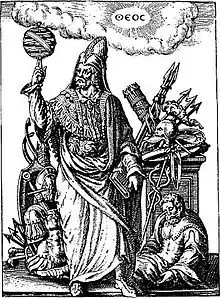The Kybalion
The Kybalion (full title: The Kybalion: A Study of the Hermetic Philosophy of Ancient Egypt and Greece) is a book originally published in 1908 by "Three Initiates" (often identified as the New Thought pioneer William Walker Atkinson, 1862–1932)[1] that purports to convey the teachings of Hermes Trismegistus. A modern Hermetic tract, it has been widely influential in twentieth- and twenty-first-century New Age circles.[2]

Seven Hermetic principles
| Part of a series on |
| Hermeticism |
|---|
 |
| Mythology |
|
Hermetic arts |
| Hermetic writings |
|
Related historical figures (ancient and medieval) |
|
|
Related historical figures (early modern) |
| Modern offshoots |
A central concept in the book is that there are "seven Hermetic principles, upon which the entire Hermetic philosophy is based".[3] These are:
1. The principle of mentalism
"The All is Mind; the Universe is Mental."[4]
2. The principle of correspondence
"As above, so below; as below, so above.” [...] This principle embodies the truth that there is always a correspondence between the laws and phenomena of the various planes of being and life.[5]
3. The principle of vibration
"Nothing rests; everything moves; everything vibrates."[6]
4. The principle of polarity
"Everything is dual; everything has poles; everything has its pair of opposites; like and unlike are the same; opposites are identical in nature, but different in degree; extremes meet; all truths are but half-truths; all paradoxes may be reconciled."[7]
5. The principle of rhythm
"Everything flows, out and in; everything has its tides; all things rise and fall; the pendulum-swing manifests in everything; the measure of the swing to the right is the measure of the swing to the left; rhythm compensates."[8]
6. The principle of cause and effect
"Every cause has its effect; every effect has its cause; everything happens according to law; chance is but a name for law not recognized; there are many planes of causation, but nothing escapes the law."[9]
7. The principle of gender
"Gender is in everything; everything has its masculine and feminine principles; gender manifests on all planes."[10]
According to Mitch Horowitz, the philosophical mentalism (the primacy of mind as the active cause of things) described by the Kybalion's first principle was inspired by broadly similar notions in the ancient Greek Hermetica.[11]
See also
- As above, so below
- Correspondence
- Emerald Tablet
- Hermetica (writings attributed to Hermes Trismegistus)
- Occultism
References
- On the identification of the author of the Kybalion as William W. Atkinson, see Deslippe 2011, pp. 18-19; Smoley 2018, pp. ix-xxv; Horowitz 2019, p. 195.
- See Horowitz 2019, pp. 193-194.
- Three Initiates 1908, p. 25 (excessive capitalization removed); cf. Brînzeu 2011, p. 263; Horowitz 2019, pp. 193-194, p. 196.
- Three Initiates 1908, p. 26.
- Three Initiates 1908, p. 28 (excessive capitalization removed).
- Three Initiates 1908, p. 30 (excessive capitalization removed).
- Three Initiates 1908, p. 32 (excessive capitalization removed).
- Three Initiates 1908, p. 35.
- Three Initiates 1908, p. 38 (excessive capitalization removed).
- Three Initiates 1908, p. 39 (excessive capitalization removed).
- Horowitz 2019, pp. 196-198.
Works cited:
- Brînzeu, Pia (2011). "Hidden Esotericism: Postmodern Witches and the Cauldron of Intertextuality". European Journal of English Studies. 15 (3): 251–265. doi:10.1080/13825577.2011.626954.
- Deslippe, Philip (2011). The Kybalion: The Definitive Edition. New York: Tarcher/Penguin. ISBN 978-1585428748.
- Horowitz, Mitch (2019). "The New Age and Gnosticism: Terms of Commonality". Gnosis: Journal of Gnostic Studies. 4 (2): 191–215. doi:10.1163/2451859X-12340073.
- Smoley, Richard (2018). The Kybalion: Centenary Edition. New York: Tarcher/Penguin. ISBN 9780143131687.
- Three Initiates (1908). The Kybalion: A Study of the Hermetic Philosophy of Ancient Egypt and Greece. Chicago: The Yogi Publication Society.